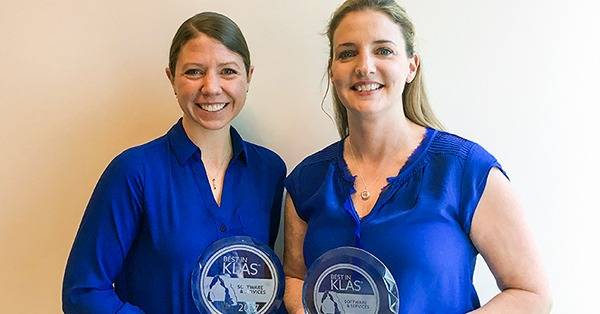- Solutions
- Solutions
- Home Health
- Hospice
- Life Plan Community
- Palliative Care
- Private Duty
- Senior Living
- Skilled Nursing
- Skilled Nursing
- Skilled Nursing Software
- Advanced Insights
- Customer relationship management
- Data and analytics
- Financial & operations management
- Marketing
- Nutrition management
- Referral management
- Regulatory compliance
- Retail management
- Resident engagement
- Revenue cycle management
- Skilled nursing interoperability
- Partners
- Blogs
- Resources
- About
- User Conference

OASIS-E1 is coming: Are you ready?
The Outcomes and Assessment Information Set (OASIS) and its associated Guidance Manual are periodically revised based on the Center for Medicare and Medicaid Services’ (CMS) addition or removal of quality measures from the Home Health Quality Reporting Program (HHQRP) or for other program requirements.
On January 1, 2023, CMS updated the OASIS instrument and Guidance Manual from OASIS-D1 to OASIS-E, which were some of the most expansive revisions to date, and were implemented to increase standardization across the post-acute care (PAC) settings. The purpose of these revisions is to more uniformly collect health data and to enable calculation of standardized, cross-setting quality measures — both of which are pursuant to the requirements in the provisions of the Improving Medicare Post-Acute Care Transformation (IMPACT) Act of 2014.
With the passing of the Calendar Year (CY) 2024 Home Health Prospective Payment System Final Rule in November of 2023, and as part of updates to the Home Health Quality Reporting Program (HHQRP), CMS finalized the adoption of two new OASIS-based quality measures, along with the removal of one existing OASIS-based measure and two long-standing OASIS items. These finalized revisions to the HHQRP will require CMS to update the current OASIS-E All Items Instrument and its associated guidance to OASIS-E1, which will be effective January 1, 2025.
In preparation for its rollout, CMS posted a Draft OASIS-E1 All Items Instrument on January 2, 2024, in the Downloads section of their OASIS Data Sets webpage. While these revisions are far less expansive than the version update from OASIS D1 to OASIS-E last year, it will still be very important for home health agencies (HHAs) to understand the new changes to ensure adequate preparation ahead of the planned implementation.
In this blog, we take a closer look at the upcoming changes.
HHQRP measure changes
Before reviewing the OASIS item changes, it’s important to understand the HHQRP measure changes finalized in the CY 2024 HH Final Rule, as these changes are a main driver behind the version update from OASIS-E to OASIS-E1.
First, CMS has finalized the proposal to remove the cross-setting process measure: Application of Percent of Long-Term Care Hospital Patients with an Admission and Discharge Functional Assessment and a Care Plan That Addresses Function (“Application of Functional Assessment/Care Plan Measure”) — beginning with the CY 2025 HHQRP. The Application of Functional Assessment/Care Plan Measure performance among HHAs has been so high and unvarying that meaningful distinctions in improvements in performance can no longer be made. With the removal of this measure, HHAs will no longer be required to report a Self-Care Discharge Goal (GG0130, Column 2) or a Mobility Discharge Goal (GG0170, Column 2) on the OASIS, thus these items will be removed.
Additionally, CMS finalized the removal of two long-standing OASIS items from the OASIS-M0110-Episode Timing, and M2200-Therapy Needs, effective January 1, 2025. These items are no longer used in the calculation of quality measures already adopted in the HHQRP, nor are they being used currently for previously established purposes unrelated to the HHQRP, including payment under PDGM.
Next, CMS is finalizing the proposal to adopt the cross-setting: Discharge Function Score (“DC Function”) Measure in the HHQRP, beginning with the CY 2025 HHQRP, which would replace the cross-setting Application of Functional Assessment/Care Plan Process Measure that is being removed from the CY 2025 HHQRP. This assessment-based outcome measure evaluates functional status by calculating the percentage of home health patients who meet or exceed an expected discharge function score, which is calculated from 11 existing GG items that consider two dimensions of function (self-care and mobility activities) and accounts for missing data by using statistical imputation to improve the validity of measure performance.
HHAs will be required to report these OASIS assessment data beginning with patients discharged on/after January 1, 2024. Because the Discharge Function Score Quality Measure is calculated based on data that are currently submitted to the Medicare program, there would be no additional information collection required from HHAs.
And last, CMS has finalized the proposal to adopt a new cross-setting assessment-based measure that reports the percentage of patients who are up to date on their COVID-19 vaccinations per the CDC’s latest guidance. This new measure, the Patient/Resident COVID-19 Vaccine Measure, is calculated by a numerator that is the total number of home health patients who are up to date with their COVID-19 vaccine during the reporting period. The denominator for the measure is the total number of home health stays with an End of Care OASIS (discharge, transfer or death at home) during the reporting period. The data source for the Patient/Resident COVID-19 Vaccine Measure will be the OASIS assessment instrument for home health patients. HHAs will be required to report this OASIS assessment data beginning with patients discharged on/after January 1, 2025.
CMS will revise the current OASIS-E by adding a new item to the item set in OASIS-E1 to collect information on whether a patient is up to date with their COVID-19 vaccine at the time of discharge from the HHA. There will be no exclusions, the response value will simply be Y or N, and it is based on the most recent CDC guidance, which is continually changing — so this has the potential to be very confusing and is a concern as to the potential to reflect poorly on the HHA’s outcome results on Care Compare.
OASIS item changes
Now that we’ve reviewed the HHQRP measure changes finalized for background context, let’s close now with a brief summary of the upcoming changes HHAs can currently expect to see with the implementation of OASIS-E1, effective January 1, 2025.
Items being removed:
- M0110-Episode Timing
- M2200-Therapy Needs
- Self-Care Goals in GG0130, Column 2
- Mobility Goals in GG0170, Column 2
Items being added:
- O0350A-COVID-19 Vaccination
Additional changes:
Additional changes found in the Draft OASIS-E1 All Items Instrument include:
- The updating of OASIS item: M2420-Discharge Disposition to include language changes in response 1 and response 2 to replace “formal assistive services” with “skilled services from a Medicare Certified HHA”
- Updates to the instructions for OASIS item: D0150-Patient Mood Interview as it relates to when to stop the interview after completing D0150A and D0150B, in addition to instruction on when to continue to ask the remaining seven D0150 questions
As we all know, OASIS accuracy is critical, as it is tied to PDGM payment and publicly reported quality outcomes — so don’t be behind when OASIS-E1 officially begins.
Request a demo today to see for yourself how MatrixCare can both prepare and support your clinicians for the critical assessment changes coming to our industry.
See what MatrixCare can do for you
Brandy Shifteh
Brandy Shifteh, RN, BHSA, MBA, joined MatrixCare in April of 2018 as a Clinical Informatics Business Analyst, where she has been very involved in the development and enhancement of clinical analytics that supports scrubbing of OASIS assessment data, casemix/HIPPS scoring, clinical assessment reviews and coding. In April of 2019, she transitioned into a Regulations Compliance role, where she is responsible for monitoring regulations that impact home health, hospice and private duty home care, to help ensure our solutions support all existing and new regulations. She is very plugged into the regulatory community with relationships at both the state and federal level and serves as an active member on the National Government Services (NGS) Vendor Coalition group, where she provides input on MAC provider education and materials. Brandy is a Registered Nurse and comes to us with over 23 years of operations management experience in the home health, hospice and private duty home care sector, inclusive of accreditation/survey preparedness, compliance and clinical/quality improvement programming. She holds two undergraduate degrees; science and nursing and health services administration; and an MBA in computer information systems (CIS).
Related Posts


See MatrixCare in action
Start by having a call with one of our experts to see our platform in action.
MatrixCare offers industry-leading software solutions. Thousands of facility-based and home-based care organizations trust us to help them improve efficiency and provide exceptional care.






